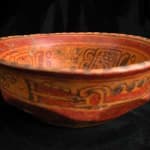Mayan Polychrome Vessel, 300 CE - 900 CE
Terracotta
7.875 x 3.127
PF.5550
Further images
A red cross-shaped motif with a solid dot in the middle decorates the center of this vessel. The interior partition of the bowl is adorned by a glyph, repeated four...
A red cross-shaped motif with a solid dot in the middle decorates the center of this vessel. The interior partition of the bowl is adorned by a glyph, repeated four times in alternating red and black hues. A series of black dots emphasizes the edge of the lip. On the outside of the bowl, a procession of hybrid animal-gods is depicted. This fantastical creature repeated three times, combines the heads of the serpent god and the alligator god together on the same body. The hook-nosed head of the serpent marks the right end while the long-jawed head of the alligator is on the left. Pre-Columbian mythology frequently merged aspects of various animals, fusing their individual strengths together in one god. Duality was a major theme in the religious beliefs of the Mayans. The opposites of day and night or male and female were united in the most powerful deities. We can therefore assume that this alligator/serpent hybrid was an extremely potent deity, especially considering the alligator’s important place in the animal hierarchy, ranking second after the jaguar. Perhaps, the most interesting aspect of this vessel is the molded, angular band just above the base. The vessel is simultaneously circular and heptagonal in nature. Thus, the actual form of this vessel is itself a hybrid of geometric shapes much like the mythical hybrid deity that decorates it.









